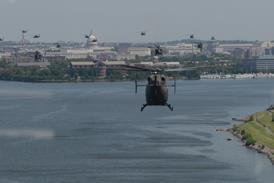Winner: Bombardier Regional Aircraft
Location: Ontario, Canada
Achievement: Helping carriers to exploit the benefits of open skies, with new low-cost, direct air services using the 50-seat Canadair Regional Jet.
FROM THE OUTSET, Bombardier designed its 50-seat Canadair Regional Jet to help airlines open up new opportunities for low-cost, direct air services, which would simply have been too expensive with existing aircraft.
With 40 of the aircraft now flying and as many on order, Bombardier has already proved its point. Air Canada's use of the Regional Jet to open up transborder routes in North America is a clear example.
The airline was keen to take full advantage of the Canada-US "open-skies" agreement signed in February 1995, planning an aggressive expansion onto new routes. Existing jet aircraft would have been too large to make these service economically viable, while the distances made turboprops impractical.
Instead, the carrier has relied on the Canadair 50-seater, making use of its low capacity and acquisition cost, to build frequency and market share while keeping break-even load factors to a minimum. At under $20 million, the aircraft is as yet the lowest-cost regional jet in airline service and the first to open up the 50-seat market.
Typical Air Canada services include routes from Toronto through to Boston or Washington on the US East Coast, but have also extended as far south as Atlanta. Hollis Harris, Air Canada chairman and a veteran of the US airline industry, believes that the Canadair Jet could be suited to open up as many as 64 Canada-US city pairs. He describes the aircraft, for which his airline was one of the first customers, as a good example of Canada's aerospace industry "...being in the right place at the right time with the right product".
US regional carrier Comair, too, is using the Canadair Regional Jet to reap the benefits of the 1995 open-skies agreement. It has already increased frequencies from its base in Cincinnati over the border to Toronto and Montreal.
The judges agreed that Canadair's aircraft has had an enormous impact on regional-airline operations.
Finalist: Cathay Pacific
Location: Hong Kong International Airport
Achievement: Pioneering cross-crew qualification and mixed-fleet flying on the Airbus A330 twinjet and the A340.
CATHAY PACIFIC not only started 1995 with the challenge of introducing both the Airbus A330 and A340 into its fleet, but had laid out a pioneering programme to become the first airline in the world to cross-qualify crews on these types.
The first of four Airbus A340s had gone into service towards the end of 1994, while the initial A330-300 followed in March 1995. Cathay's aim was to follow up with cross-crew qualification (CCQ) and mixed-fleet flying as soon as possible and it has succeeded.
The first crews completed the CCQ the following September, only seven months after the first A330 had touched down in Hong Kong. So far, 30 pilots are qualified for mixed-fleet operations, and eventually the rest will follow.
In all, nearly 200 pilots have been trained to fly the new Airbus fleet mostly in-house. Cathay's Airbus simulator doubles for both aircraft types, and conversion now takes 45min.
By pioneering CCQ across four-engined and twinet aircraft, the judges felt that Cathay had helped the aviation industry take a significant step forward.
Finalist: Sun Country Airlines
Location: Mendota Heights, Minnesota, USA
Achievement: Receiving the first-ever sole-use approval for satellite navigation in oceanic air space.
ON 1 AUGUST, 1995, Sun Country Airlines wrote itself into the aviation history books, when it became the first carrier in the world to receive operational approval to use the global-positioning-system (GPS) as sole means of navigation in oceanic and remote airspace.
Satellite-based navigation is on the verge of revolutionising the world air-transport industry, and the Awards judges acknowledged that Sun Country's approval took that revolution another step forward.
Approval was granted following a validation flight across the Atlantic in a Boeing 727-200 equipped with dual Trimble TNL8100 GPS navigation systems. The approval was also granted six months earlier than the best estimates of the US Federal Aviation Administration.
Sun Country has plans to continue its pioneering work in satellite navigation, taking advantage of new systems for landing and approaches due to come onstream in the USA over the next decade.
Source: Flight International























